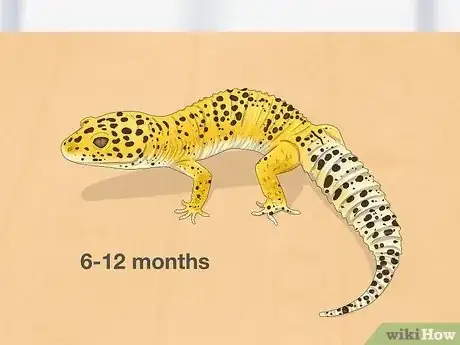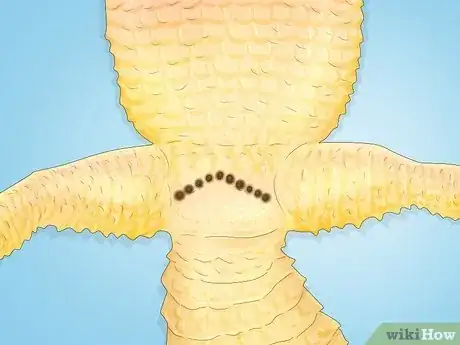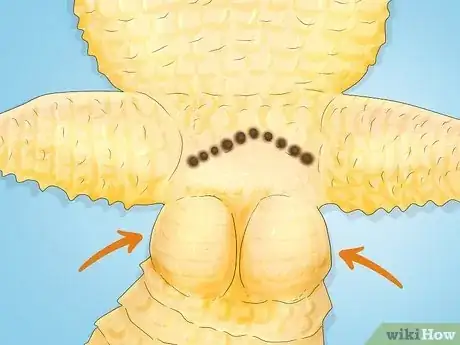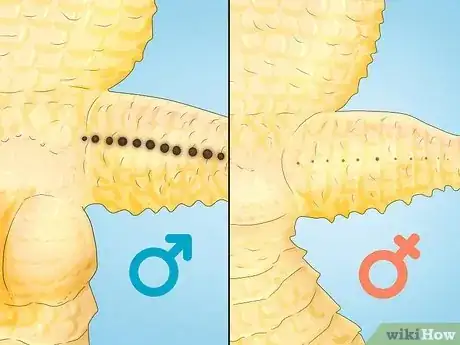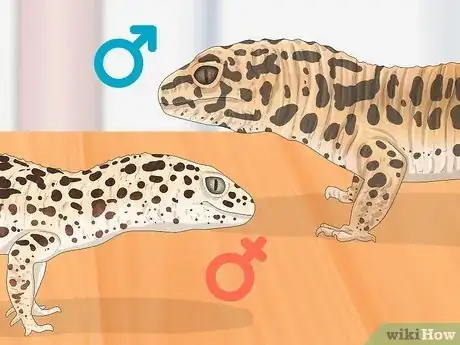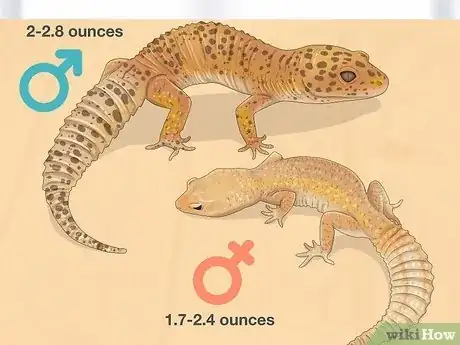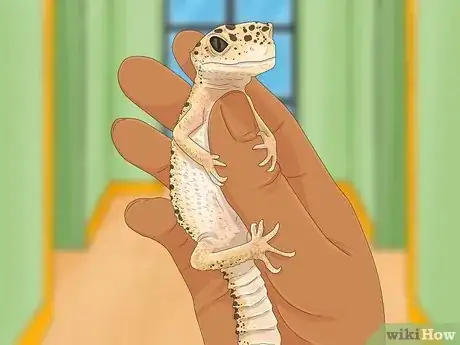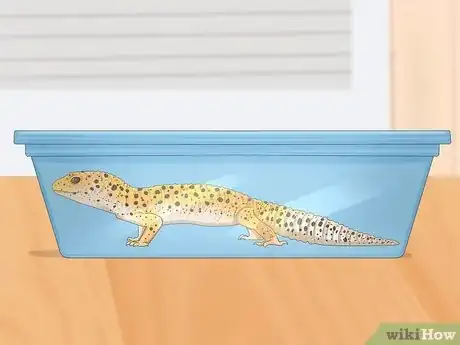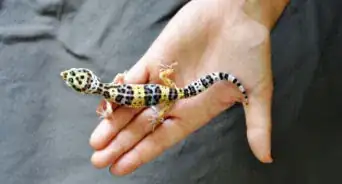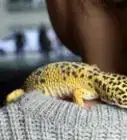This article was written by Audra Barrios and by wikiHow staff writer, Devin McSween. Audra Barrios is a Marine Biologist and owner of Lick Your Eyeballs, a business offering experiemces, reptiles, supplies and plants. With over 15 years of experience, Audra specializes in reptiles and exotic animals, environmental education, marine biology, conservation issues, and animal husbandry. Audra earned a BASc in Marine Biology from the University of California, Santa Cruz, and studied Natural Sciences at the College of Marin. She is the founder and Executive Director of Things That Creep, a non-profit dedicated to herptile conservation through education. She has spent the last nine years working as a biologist at the California Academy of Sciences.
There are 8 references cited in this article, which can be found at the bottom of the page.
This article has been viewed 1,341 times.
With their distinctive black spots and yellow bodies, leopard geckos are one of the coolest geckos to keep as a pet. However, male and female leopard geckos look super similar, so it can be difficult to tell which one you have. Well, wonder no longer! In this article, we’ll show you 3 things to check to determine your leopard gecko’s sex. Then, we’ll tell you about some other ways to tell a male and female gecko apart. Read on to find out the sex of your gecko!
This article is based on an interview with our marine biologist and reptile specialist, Audra Barrios, owner of Lick Your Eyeballs. Check out the full interview here.
Things You Should Know
- Sex your gecko by examining their underside when they’re 6-12 months old.
- At the base of their tale, male geckos have 2 distinctive bulges and larger, darker V-shaped pores than females.
- Male geckos tend to be longer, weigh more, and have wider, bulkier heads than females.
- The temperature your gecko was incubated at can tell you whether they’re male or female.
Steps
Determining if Your Leopard Gecko is Male of Female
-
1Wait until your gecko is about 6 to 12 months old to determine their sex. Leopard geckos don’t start showing important sex differences until they are fully matured. If you examine them before the 6 to 12 month mark, there won’t be any differences to see![1]
- It’s important to know whether your gecko is a male or female if you want to give them a companion or breed them. While female geckos can live together, males cannot. Male geckos are territorial and will fight each other.[2]
-
2Male leopard geckos have larger, more visible pre-anal pores. When you examine your gecko, look for a V-shaped line of brown dots on their belly. These pores are located slightly above the base of their tail, or where their body and tail meet. If you do see dots on your gecko’s underside, you likely have a male gecko.[3]
- While female leopard geckos do have pre-anal pores, they are usually invisible. If they are slightly visible, they are typically clear instead of brown.
- Male geckos secrete a waxy substance from their pre-anal pores. The substance contains pheromones that attract females when males want to mate.
Advertisement -
3Male leopard geckos have hemipenal bulges while females don’t. While looking at the underside of your gecko, check for bulging below their vent, or the opening where they defecate and reproduce. This is located at the base of their tail. If your gecko is male, there will likely be 2 distinct bulges on each side. Females don’t have hemipenal bulges, so the base of their tail is usually flat.[4]
- On most male geckos, their hemipenal bulges contain their reproductive organs. So, it makes sense why females don’t have these bulges.
-
4The femoral pores on male geckos are larger and darker than females’. Moving from your gecko’s belly, check out the underside of their upper thighs. On male geckos, femoral pores look like a bunch of brown or tan dots running horizontally across their thigh. While female geckos have these pores too, they are much smaller and often barely visible.[5]
- Femoral pores release an oily substance that is also full of pheromones. Geckos lick a fellow gecko’s pores to determine whether they’re male or female. The pheromones are also used to attract interested mates.
- Generally, pre-anal pores and hemipenal bulges are more reliable ways to tell if your gecko is male or female. Once you’ve checked for those and have your answer, looking at their femoral pores can confirm their sex.
Other Ways to Tell Your Gecko’s Sex
-
1The temperature your gecko was incubated at can tell you their sex. It might be surprising that a leopard gecko's sex is often determined by their egg incubation temperature. In general, eggs that are incubated at 79° F (26° C), 86° F (30° C), and 93° F (34° C) result in mostly female geckos. On the other hand, breeders produce mostly males when eggs are incubated at around 90° F (32.5° C).[6]
- Ask your breeder what temperature your gecko was incubated at. If they don’t know, that’s okay. The best way to tell if your gecko is male or female is still to wait until they’ve reached maturity and check for pores and hemipenal bulges.
-
2Male leopard geckos are usually larger than female geckos. This isn’t the most reliable way to tell if your gecko is male or female, as their sizing can be very similar. Generally though, male geckos range from 8 to 11 inches (20-28 cm) long while females are typically 7 to 8 inches (17-20 cm) long.[7]
- While leopard geckos are pretty small, to properly care for them, keep them in a tank that’s at least 20 gallons (75 L) large.
-
3Female leopard geckos might have smaller heads than males. Along with their length, male geckos tend to have larger heads than females. A male gecko’s head is usually wider and bulkier than females’ thinner, slender heads.[8]
-
4Male leopard geckos also typically weigh more than female geckos. Like with their size, male and female leopard geckos’ weight differences are slight. On average, male geckos tend to weigh 2 to 2.8 ounces (60-80 g) while females typically weigh 1.7 to 2.4 ounces (50-70 g).[9]
-
5Female leopard geckos lay eggs while male geckos do not. This can seem like an obvious way to tell if your gecko is male or female. However, you might not know that females can lay eggs without a male around! It’s not the best method, but if you’re still not sure whether your gecko is a male or female, patiently wait to see if yours lays any eggs.
- However, without a male around, a female’s eggs are infertile. So, no baby geckos will come from her eggs.
- If you want to breed leopard geckos, place a male and female in the same enclosure and let nature take its course. Once the female’s laid eggs, remove them, being careful not to rotate or roll them. Put them in a plastic cup that's full of soil that’s slightly damp. Then, place a lid on top with holes poked through it. You can then put the cup back in the enclosure, or set up a separate incubation station.
Holding Your Gecko
-
1Approach your gecko carefully and scoop them up with your hand. Leopard geckos can get frightened easily, so watch out for signs that they’re anxious or afraid before picking them up. If they come towards your hand when you place it in their enclosure, gently scoop them up from under their belly.[10]
- If your leopard gecko is hiding from you, drooping their tail, or running away, back off and approach them once they’ve calmed down.
- When leopard geckos are frightened and stressed, they can drop their tail. While their tail regrows, picking them up when they’re not stressed can prevent this from happening.
-
2Keep your grip loose as you check their underside. A loose grip is the best way to hold your gecko so they don’t jump out of your hands and get squished from your pressure. Gently grab them on either side of their body and hold them up vertically in front of your face.[11]
- Be sure not to place your gecko on their back or squeeze them tightly. This is uncomfortable for them, which can stress them out.[12]
-
3Examine your gecko in a clear, plastic container if they’re struggling. If your gecko doesn’t want to be handled, don’t force it! You can easily examine their underside by placing them in a clear plastic container. Just hold the container over your head to get a good look at your gecko.[13]
References
- ↑ https://reptophile.com/leopard-gecko-sexing/
- ↑ https://leopardgeckoland.com/leopard-gecko-gender/
- ↑ https://www.thebeardeddragon.org/leopard-gecko/basics
- ↑ https://geckoadvice.com/how-to-sex-leopard-gecko/
- ↑ https://reptophile.com/leopard-gecko-sexing/
- ↑ https://pubmed.ncbi.nlm.nih.gov/8047573/
- ↑ https://animals.sandiegozoo.org/animals/leopard-gecko
- ↑ https://www.ncbi.nlm.nih.gov/pmc/articles/PMC2855288/
- ↑ https://geckoadvice.com/how-to-sex-leopard-gecko/
